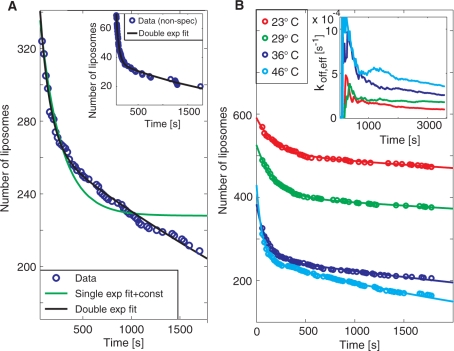Figure 2.
(A) A typical dissociation trend for the fully complementary target at 36°C, showing the number of individual liposomes which still remain bound to the surface after a certain residence time (see also Figure 1B). To avoid influence from unspecific binding, liposomes that remained at the same position within the evanescent field for less than three frames (60 s) are not accounted for in the analysis. The dissociation rate was fitted with two (black line) and one, and an irreversible fraction, (green line) dissociation rate constants. From the double exponential fit ( f(t) = A1exp(−koff,1t) + A2exp(−koff,2t)) typical values for koff,1 and koff,2 were 0.007 s−1 and 1 × 10−4 s−1, respectively, at 36°C. Inset: Dissociation trend for non–specific interactions of liposomes at 23°C with koff,1 = 0.02 s−1 and koff,2 = 4 × 10−4 s−1. (B) The same type of data as in A for 23, 29, 36 and 46°C. Inset: Accumulative representation of the number of liposomes that has bound and subsequently lost contact with the surface divided with the total number of liposomes that has bound to the surface [Equation (1)], for the different temperatures.

